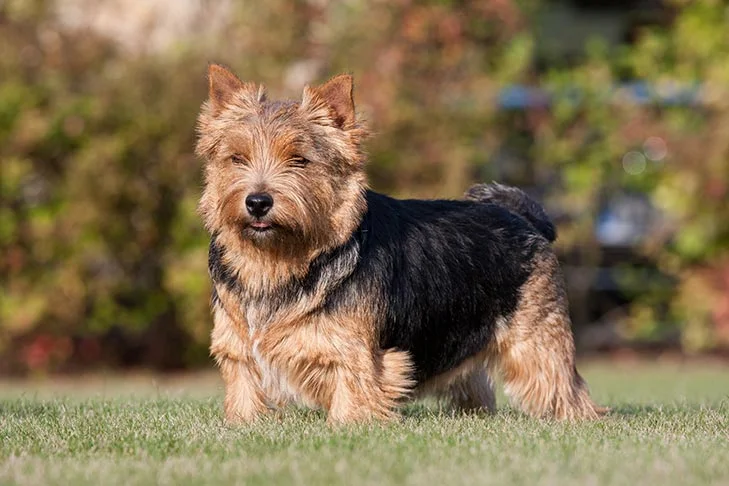The tenacious little earth dogs known as Norwich Terriers were called for their birthplace in England. The phrase “a big dog in a small package” was first used to describe breeds like the Norwich, who can be unaware of their small stature at just 10 inches. The Norwich are among the tiniest working terriers, standing little taller than 10 inches at the shoulder and weighing about 12 pounds. There is a large, sturdy dog hidden beneath the hard, wiry coat. Despite their diminutive stature, Norwiches are not satin-pillow dogs; rather, they were first developed as hardy ratters. Their upright, pointed ears set them apart from their canine twin, the Norfolk Terrier. Happy-go-lucky, brave, and occasionally even domineering, Norwiches are affectionate enough to enjoy hours of lap time with their favorite person yet energetic enough to play fetch all day. With this intelligent but occasionally stubborn breed, brief, encouraging training sessions are best. The puppy can be described in three words: cute, cuter, and cutest.
Norwich Terrier
Average sizes and life
expectancy of the breed.
Height
10 inches
Weight
12 pounds
Life Expectancy
12-15 years
Breed Traits & Characteristics
About the Breed

Owning a dog is not just a privilege; it’s a responsibility. They depend on us for, at minimum, food and shelter, and deserve much more. When you take a dog into your life, you need to understand the commitment that dog ownership entails.
 Health
Health
Recommended Health Tests From the National Breed Club:
- Patella Evaluation
- Hip Evaluation
- Ophthalmologist Evaluation
 Grooming
Grooming
 Exercise
Exercise
The Norwich retains its original hunting instincts and jovial temperament. They are inquisitive and energetic, and they should be in a fit condition for the day's activities. They require ample exercise to benefit their mental and physical health. Because of their innate hunting instincts, they must be walked on a leash or let out only in a securely fenced area.
 Training
Training
Norwich is spirited little terriers, and they are usually eager to please and respond well to training. Puppies should be properly socialized to develop the amiable, outgoing personality that is characteristic of the breed. They're successful in performance and companion events such as earth dog, barn hunt, obedience, and agility.
 Nutrition
Nutrition
History
The Norwich Terrier is one of the terriers breeds that have been developed to reduce the rat population in Britain. Norwiches were raised to be more gregarious than the typical independent-minded terrier since they were employed in packs on foxhunts and as rats.
Norwich is infamously linked to Cambridge University, where undergraduates developed a taste for Norwich ownership in the 1870s and 1880s. Trumpington Terriers are the name given to the kind of dogs that the students bought as pets and dorm room rats from a livery stable on nearby Trumpington Street. A Norwich stableyard owner got into the possession of one of these dogs, who was given the name Rags. Rags were reared, produced a number of exceptional litters, and are now regarded as the ancestor of modern Norwich.
When a British man by the name of Frank “Roughrider” Jones used descendants of Rags to breed a dog named Willum, the breed’s American history officially began. Willum was shipped to Philadelphia, where he established himself as the American breed’s stalwart sire. These happy, prick-eared terriers were so strongly linked to Roughrider Jones that American breeders began referring to them as the Jones Terrier. American breed aficionados referred to their adorable little pups as Jones Terriers for a very long time after the breed was recognized as the Norwich Terrier by the English and American kennel associations in the 1930s.



